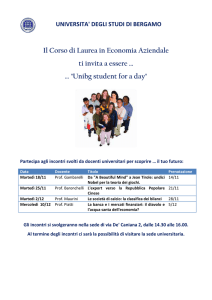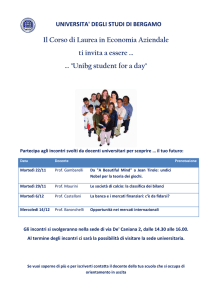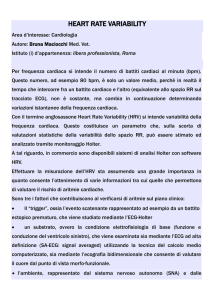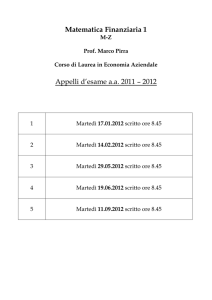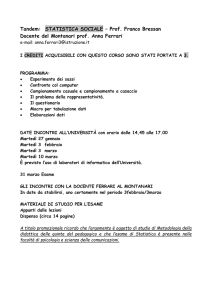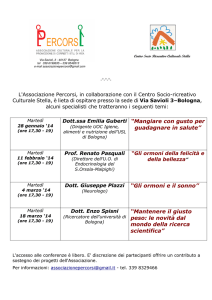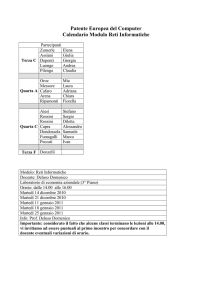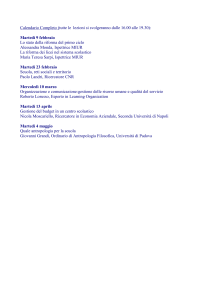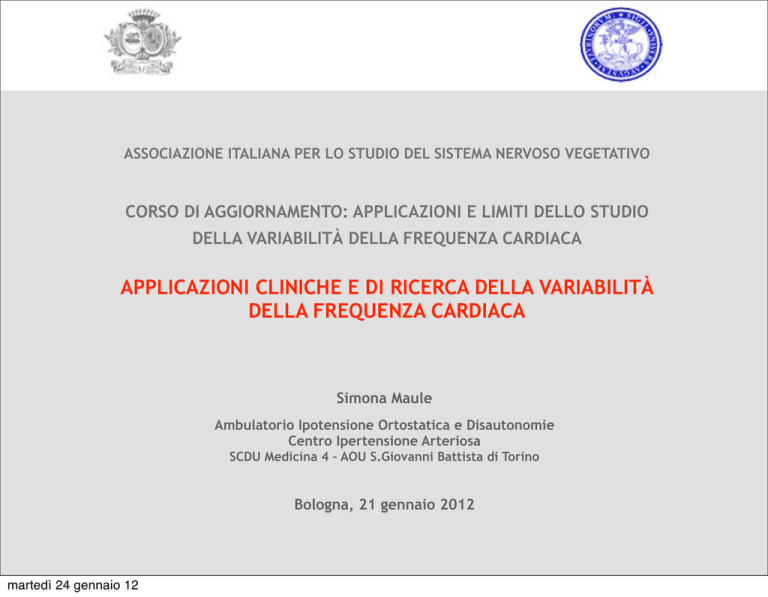
ASSOCIAZIONE ITALIANA PER LO STUDIO DEL SISTEMA NERVOSO VEGETATIVO
CORSO DI AGGIORNAMENTO: APPLICAZIONI E LIMITI DELLO STUDIO
DELLA VARIABILITÀ DELLA FREQUENZA CARDIACA
APPLICAZIONI CLINICHE E DI RICERCA DELLA VARIABILITÀ
DELLA FREQUENZA CARDIACA
Simona Maule
Ambulatorio Ipotensione Ortostatica e Disautonomie
Centro Ipertensione Arteriosa
SCDU Medicina 4 – AOU S.Giovanni Battista di Torino
Bologna, 21 gennaio 2012
martedì 24 gennaio 12
HRV
DEFINIZIONE
Oscillazione dell’intervallo tra frequenze cardiache
(intervallo RR) istantanee successive
Dipende dalla funzione autonomica
È un indice di controllo autonomico della circolazione
martedì 24 gennaio 12
SISTEMA NERVOSO AUTONOMO: RUOLO
Controllo cardiovascolare
Funzione endocrina
Termoregolazione
Omeostasi
Motilità gastroenterica
Escrezione urinaria
e intestinale
martedì 24 gennaio 12
Metabolismo
Riproduzione
SISTEMA NERVOSO AUTONOMO: RUOLO
martedì 24 gennaio 12
reazione difesa-attacco
1944
martedì 24 gennaio 12
Darwin C, 1872
Hess WR,
reazione difesa-attacco
- modificazioni posturali
- modificazioni
autonomiche
tachicardia
vasodilatazione muscolare
vasocostrizione cutanea, splancnica, renale
↑ pressione arteriosa (inibizione baroriflesso)
1944
martedì 24 gennaio 12
Darwin C, 1872
Hess WR,
TONO AUTONOMICO
Attivazione simpatica: risposta allo stress fisico e psichico
Eventi gravi: shock cardiocircolatorio, ipotensione, broncocostrizione…
Eventi minori: congestione nasale, stanchezza, “rush
adrenalinico”…
Quando e come diventa un fattore di rischio?
martedì 24 gennaio 12
TONO AUTONOMICO
Quando?
Iperstimolazione simpatica cronica (e ridotto tono vagale)
Curtis, O’Keefe 2002
martedì 24 gennaio 12
TONO AUTONOMICO
Come?
Iperstimolazione simpatica cronica
Aumento lavoro cardiaco
Disfunzione endoteliale
Spasmo vascolare (es. coronarico)
Alterazione tono vascolare ed emodinamica (turbolenza)
Proliferazione cellule muscolari lisce
Ipertrofia ventricolare sinistra
Attivazione metabolismo lipoproteico (ateromi)
Stato pro-infiammatorio
Attivazione RAAS
Iperinsulinemia
Aritmie indotte da ischemia
Mortalità cardiaca e aritmica
martedì 24 gennaio 12
HRV
HRV = indice di controllo autonomico della circolazione
Studi su animali: blocco
o amplificazione del
SNA e misura delle
modifiche di HRV
Studi sull’uomo:
manipolazione
farmacologica del
SNA
Studi su pazienti con
neuropatia autonomica o con
disfunzione autonomica:
diabete, scompenso
cardiaco, IMA, ipertensione,
PAF, lesioni spinali, …
POTENTE PREDITTORE INDIPENDENTE DI PROGNOSI
CARDIOVASCOLARE
martedì 24 gennaio 12
HRV: STUDI
Taylor, Studinger 2006
martedì 24 gennaio 12
HRV: STUDI
POPOLAZIONE GENERALE
DIABETE E S. METABOLICA
IMA-CARDIOPATIA ISCHEMICA CRONICA
SCOMPENSO CARDIACO
IRC
IPERTENSIONE E PRE-IPERTENSIONE
OSAS
martedì 24 gennaio 12
HRV: STUDI
POPOLAZIONE GENERALE
DIABETE E S. METABOLICA
IMA-CARDIOPATIA ISCHEMICA CRONICA
SCOMPENSO CARDIACO
IRC
IPERTENSIONE E PRE-IPERTENSIONE
OSAS
NEUROPATIA AUTONOMICA PRIMITIVA
LESIONI SPINALI
SINCOPI NEUROMEDIATE
DEPRESSIONE E ALTRE MALATTIE PSICHIATRICHE
FIBROMIALGIA REUMATICA
DOLORE CRONICO
MALATTIE INFIAMMATORIE INTESTINALI
DISORDINI ALIMENTARI
CACHESSIA TUMORALE
EPILESSIA
ICTUS
CIRROSI EPATICA
GRAVIDANZA E PATOLOGIE CORRELATE ….
martedì 24 gennaio 12
HRV E POPOLAZIONE GENERALE
Circulation 1994
martedì 24 gennaio 12
HRV E POPOLAZIONE GENERALE
Circulation 1994
martedì 24 gennaio 12
HRV E POPOLAZIONE GENERALE
martedì 24 gennaio 12
HRV E POPOLAZIONE GENERALE
martedì 24 gennaio 12
HRV E POPOLAZIONE GENERALE
martedì 24 gennaio 12
HRV E POPOLAZIONE GENERALE
Am J Epidemiol 1999
martedì 24 gennaio 12
HRV E POPOLAZIONE GENERALE
Europace 2006
martedì 24 gennaio 12
HRV E POPOLAZIONE GENERALE
Eur J Epidemiol 2009
martedì 24 gennaio 12
HRV E DIABETE
Diabete e sindrome metabolica
Iperinsulinemia
Iperstimolazione simpatica
Ridotta HRV
(Liao 1998, Laitinen 1999, Singh 2000)
Aumento rischio eventi CV
martedì 24 gennaio 12
HRV E DIABETE
La riduzione di HRV (disfunzione autonomica) precede
l’alterazione dei test autonomici cardiovascolari
(neuropatia autonomica)
Spallone 2011
martedì 24 gennaio 12
HRV E DIABETE
Diabetici senza neuropatia autonomica presentano:
normale HRV a riposo
mancate variazioni fisiologiche HRV durante test
ortostatico
Diabetici con neuropatia autonomica presentano:
ridotta HRV a riposo
(Bernardi 1986, Pagani 1988, Bellavere 1992)
martedì 24 gennaio 12
HRV E DIABETE
Associazione tra NA e mortalità nei diabetici (Maser 2003)
TEST CV
martedì 24 gennaio 12
HRV E DIABETE
Associazione tra ridotta HRV e mortalità nei diabetici: risultati non univoci
HOORN Study (Gerritsen 2001)
n=605 soggetti popolazione generale stratificati con OGTT
Età 50-75
Follow-up 9 anni
Ridotta HRV predice mortalità nella sola popolazione diabetica
(non significatività per tutti i parametri)
martedì 24 gennaio 12
HRV E DIABETE
Associazione tra ridotta HRV e mortalità nei diabetici: risultati non univoci
ARIC Study (Liao 2002)
n=11654 soggetti, diabetici n=1275
Età 45-65
Folow-up 8 anni
Ridotta HRV predice sviluppo CAD, non predice mortalità coronarica e generale
martedì 24 gennaio 12
HRV E DIABETE
Associazione tra ridotta HRV e mortalità nei diabetici: risultati non univoci
MONICA/KORA Study (Ziegler 2008)
n=160 diabetici e n=1560 non diabetici
Età 55-74
Follow-up 9 anni
Ridotta HRV tende ad essere associata a mortalità nella sola popolazione
diabetica
martedì 24 gennaio 12
HRV E DIABETE
Associazione tra ridotta HRV e mortalità nei diabetici: risultati non univoci
ACCORD Study (Pop-Busui 2010)
n=8135 diabetici tipo 2
Età media 60.3, 40% donne
Follow-up 3.5 anni
Ridotta HRV associata a mortalità CV e generale
martedì 24 gennaio 12
HRV E DIABETE
Marked abnormalities in heart rate variability are associated with progressive deterioration of
renal function in type I diabetic patients with overt nephropathy
Burger AJ, D’Elia JA, Weinrauch LA, Lerman I, Gaur A
Int J Cardiol. 2002
Background: Cardiac autonomic neuropathy is a common complication of long-standing, type 1
diabetes and is associated with increased morbidity and mortality. Impaired heart rate variability is
a sensitive and reproducible marker of cardiac autonomic neuropathy. We sought to examine the
relationship between cardiac autonomic neuropathy as assessed by heart rate variability and overt
nephropathy, with emphasis on the progression of renal dysfunction over 1 year. Method: Baseline
and 12 month clinical and biochemical characteristics, as well as autonomic function tests, were
analyzed in 23, type 1 diabetic patients (mean age 37±10 years, 65% males), who were
prospectively enrolled as a part of a multi-center investigation. In addition, ambulatory, 24-h, 3channel electrocardiograms were recorded, and heart rate variability indices were assessed in the
time and frequency domains over the same period. Results: All heart rate variability indices were
markedly decreased in our study population. On univariate analysis, heart rate variability was
associated with creatinine clearance, and to a lesser extent, mean 24-h blood pressures and
cholesterol. On multivariate analysis, only heart rate variability was a significant and independent
predictor of abnormalities in creatinine clearance. Severe reduction in heart rate variability at
baseline was also significantly associated with the further deterioration in renal function at 1 year.
Conclusion: Heart rate variability is significantly reduced in long-standing, type 1 diabetics with
proteinuria or overt nephropathy. Marked abnormalities in heart rate variability are significantly
associated with and predictive of progressive renal deterioration at 1 year. These findings may
have implications for aggressive medical intervention to improve prognosis and survival in this
population.
martedì 24 gennaio 12
HRV E DIABETE
Diabetes Prevention Program Study
n=2980 soggetti ad alto rischio di sviluppare diabete
Follow-up 3.2 anni
prevenzione diabete nel braccio in terapia con le
modificazione di stile di vita coincide con miglioramento
dei parametri HRV (Carnethon 2006)
martedì 24 gennaio 12
HRV E DIABETE
Altri studi di intervento nei diabetici
Effetto favorevole su HRV di:
-Acido alfa-lipoico
-ACE-inibitori
-Antagonisti recettori ATII
-Beta-bloccanti cardioselettivi (metoprololo, nebivololo,
bisoprololo)
-Verapamil
-Digossina
Spallone 2011
martedì 24 gennaio 12
HRV E DIABETE
martedì 24 gennaio 12
HRV E DIABETE
Aronson 1997
martedì 24 gennaio 12
HRV E DIABETE
Spallone 2009
martedì 24 gennaio 12
HRV E DIABETE
Rev Endocr Metab Disord 2010
martedì 24 gennaio 12
HRV E DIABETE
Rev Endocr Metab Disord 2010
martedì 24 gennaio 12
HRV E DIABETE
Rev Endocr Metab Disord 2010
martedì 24 gennaio 12
HRV E DIABETE
RUOLO HRV NEL DIABETE
-RICERCA
-DIAGNOSI PRECOCE DI DISFUNZIONE E NEUROPATIA
AUTONOMICA
-POSSIBILITA’ DI INTERVENTI TERAPEUTICI
-STRATIFICAZIONE PROGNOSTICA
- Mortalità
- Complicanze del diabete
- Morte improvvisa ?
mod. da Spallone 2011
martedì 24 gennaio 12
HRV E DIABETE
Cardiovascular autonomic neuropathy in diabetes: clinical impact, assessment,
diagnosis, and management
martedì 24 gennaio 12
Spallone 2011
HRV E IMA
Riduzione HRV dopo IMA
meccanismi:
(1) modifica geometria cardiaca (ipocontrattilità segmentaria,
segmenti necrotici) distorsione meccanica terminali
sensitivi firing simpatico abnorme
(2) ridotta risposta delle cellule del nodo del seno alla
modulazione nervosa
martedì 24 gennaio 12
HRV E IMA
Am J Cardiol. 1987
Heart rate variability as an index of sympathovagal interaction after acute myocardial infarction.
Lombardi F, Sandrone G, Pempruner S, Sala R, Garimoldi M, Cerutti S, Baselli G, Pagani M, Malliani A.
Abstract
By analysis of spectral components of heart rate variability, sympathovagal interaction was assessed
in patients after acute myocardial infarction (AMI). At 2 weeks after AMI (n = 70), the low-frequency
component was significantly greater (69 +/- 2 vs 53 +/- 3 normalized units [NU], p less than 0.05)
and the high-frequency component was significantly smaller (17 +/- 1 vs 35 +/- 3 NU) than in 26
age-matched control subjects. This difference was likely to reflect an alteration of sympathovagal
regulatory outflows with a predominance of sympathetic activity. At 6 (n = 33) and 12 (n = 29) months
after AMI, a progressive decrease in the low- (62 +/- 2 and 54 +/- 3 NU) and an increase in the highfrequency (23 +/- 2 and 30 +/- 2 NU) spectral components was observed, which suggested a
normalization of sympathovagal interaction. An increase in sympathetic efferent activity induced by
tilt did not further modify the low-frequency spectral component (78 +/- 3 vs 74 +/- 3 NU) in a
subgroup of 24 patients at 2 weeks after AMI. Instead, 1 year after AMI, this maneuver was
accompanied by an increase in the low-frequency component (77 +/- 3 vs 53 +/- 3 NU, p less than
0.05) of a magnitude similar to the one observed in control subjects (78 +/- 3 vs 53 +/- 3 NU). These
data indicate that the sympathetic predominance that is detectable 2 weeks after AMI is followed by
recovery of vagal tone and a normalization of sympathovagal interaction, not only during resting
conditions, but also in response to a sympathetic stimulus.
martedì 24 gennaio 12
HRV E IMA
Pattern bifasico dell’HRV durante IMA in trattamento con angioplastica
primaria (Hamaad 2004)
PTCA primaria
trombolisi sistemica
martedì 24 gennaio 12
HRV E IMA
La riduzione dell’HRV predice la mortalità post-IMA (Kleiger 1987, Bigger 1992,
Hartikainen 1996, …)
Correlazione con morte improvvisa (Cripps 1991, Odemuyiwa 1994, Bigger 1993) e
aritmie ventricolari (Farrel 1991, Perkiomaki 1997)
Valore predittivo mantenuto anche dalle analisi su misurazioni brevi, a
confronto di quelle sulle 24h (Fei 1996, Bigger 1993)
Valore predittivo indipendente da funzione VS e sede infartuata (Vaishnav
1994) e superiore alla frazione d’eiezione (Copie 1996)
Valore prognostico mantenuto anche dopo fibrinolisi (Zuanetti 1996)
Il timing di misurazione dell’HRV dopo IMA ha un’influenza diretta sul
significato prognostico a causa del remodeling elettrico e meccanico (Exner
2007, Huikuri 2009)
Il valore prognostico dell’HRV dipende anche dalla funzione VS e la gravità
dell’insufficienza cardiaca (Makikallio 2001, 2005)
martedì 24 gennaio 12
HRV E IMA
Frequency domain measures of heart period variability and
mortality after myocardial infarction
Bigger 1992
martedì 24 gennaio 12
HRV E IMA
La Rovere 1998
martedì 24 gennaio 12
HRV E IMA
La Rovere 1998
martedì 24 gennaio 12
HRV E CAD
Pazienti con CAD presentano un’alterazione del ritmo
circadiano dell’HRV (Huikuri 1994)
L’evento ischemico è preceduto da un aumento del tono
simpatico (Bernardi 1988)
Relazione temporale tra HRV e episodi ischemici ricorrenti:
“vagal withdrawal” può essere identificato fino a 10 min
prima della modificazione ischemica dell’ECG e può durare
fino a 20 min dopo l’evento (Kop 2001)
I parametri HRV predicono la progressione delle lesioni
coronariche (Huikuri 1999) e la severità angiografica delle
stesse (Hayano 1990)
martedì 24 gennaio 12
HRV E CAD
Studi angiografici su stenosi coronariche:
Progressione stenosi più marcata in pz con ridotta HRV, dopo correzione per
i comuni fattori di rischio e la gravità dell’ischemia, e soprattutto delle
porzioni coronariche prossimali
(Huikuri 1999)
Lesione coronarica: riduzione HRV solo nei pz con concomitante disfunzione
segmentaria Vsin (Bonaduce 1994)
Meccanismi di interazione tra HRV e lesione coronarica? (sperimentali)
-Perdita del flusso pulsatile con formazione di turbolenza endovascolare
-Proliferazione di cellule muscolari lisce vascolari indotta da ipertono
simpatico
-Effetto pro-aterogeno dell’ipertono simpatico
martedì 24 gennaio 12
HRV E CAD
Associazione tra ridotta HRV e infiammazione
Evidenziata in numerosi studi su pazienti coronaropatici (Lanza 2006, Janszky
2004) e popolazione generale (Araujo 2006, Sajadieh 2004, Sien 2008, Lampert 2008)
Meccanismi:
fumo, obesità, inattività, ipertensione,
diabete, ipercolesterolemia,
depressione…
alterazione autonomica (HRV)
stato infiammatorio
progressione CAD e mortalità
martedì 24 gennaio 12
HRV E MOF
Prognostic impact of autonomic information flow in multiple organ
dysfunction syndrome patients
Hoyer 2005
Autonomic dysfunction predicts mortality in patients with multiple
organ dysfunction syndrome of different age groups
Schmidt 2005
Studio prospettico
90 pz
Follow-up 28 giorni
HRV ha ruolo prognostico
lnVLF >3.9 lnms
lnVLF ≤3.9 lnms
martedì 24 gennaio 12
HRV E IMA
martedì 24 gennaio 12
HRV E IMA
Am J Cardiol 1994
Effects of beta blockers (atenolol or metoprolol) on heart rate variability after
acute myocardial infarction.
Sandrone G, Mortara A, Torzillo D, La Rovere MT, Malliani A, Lombardi E.
Abstract
This study analyzed, with spectral techniques, the effects of atenolol or metoprolol
on RR interval variability in 20 patients 4 weeks after the first uncomplicated
myocardial infarction. Beta blocker-induced bradycardia was associated with a
significant increase in the average 24-hour values of RR variance (from 13,886 +/1,479 to 16,728 +/- 1,891 ms2) and of the normalized power of the high-frequency
component (from 22 +/- 1 to 28 +/- 2 normalized units), whereas the low-frequency
component was greatly reduced (from 60 +/- 3 to 50 +/- 3 normalized units). When
considering day and nighttime separately, the effects of both drugs were more
pronounced in the daytime. In addition, a marked attenuation was observed in the
circadian variation of the low-frequency component after beta blockade. As a result,
the early morning increase of the spectral index of sympathetic modulation was no
longer detectable. These results indicate that beta-blocker administration has
important effects on RR interval variability and on its spectral components. The
observed reduction in signs of sympathetic activation and the increase in vagal tone
after beta blockade help to explain the beneficial effects of these drugs after
myocardial infarction. However, the potential clinical relevance of the increase in RR
variance remains to be established.
martedì 24 gennaio 12
HRV E IMA
Curtis, O’Keefe 2002
martedì 24 gennaio 12
HRV E IMA
MORTE
IMPROVVISA
Liew 2011
martedì 24 gennaio 12
HRV E IMA
MORTE IMPROVVISA
Liew 2011
martedì 24 gennaio 12
HRV E IMA
RUOLO HRV NELL’IMA
-RICERCA
-DIAGNOSI PRECOCE DI DISFUNZIONE AUTONOMICA
-POSSIBILITA’ DI INTERVENTI TERAPEUTICI
-STRATIFICAZIONE PROGNOSTICA
- Mortalità
- Complicanze aritmiche
- Morte improvvisa ? Impianto ICD ?
Guidelines 1996
martedì 24 gennaio 12
HRV E SCOMPENSO CARDIACO
CAD, ipertensione, alcoolismo, miocardite virale…
Stimolazione simpatica
Attivazione RAAS
Vasocostrizione
Aritmie
Apoptosi
Progressiva disfunzione Vsin
Scompenso cardiaco
Terapia con beta-bloccanti ha rivoluzionato la prognosi
(Packer 1996, Dargie 2001 )
martedì 24 gennaio 12
HRV E SCOMPENSO CARDIACO
Classe NYHA II-III
riduzione HRV totale con aumento
relativo componente LF
Classe NYHA IV riduzione HRV con residua
componente HF
Malliani 1991, Fleisher 1996
martedì 24 gennaio 12
HRV E SCOMPENSO CARDIACO
Guidelines 1996
martedì 24 gennaio 12
HRV E SCOMPENSO CARDIACO
Prospective Study of Heart Rate Variability and Mortality in Chronic Heart Failure : Results
of the United Kingdom Heart Failure Evaluation and Assessment of Risk Trial (UK-Heart)
Nolan martedì 24 gennaio 12
Circulation 1998
HRV E SCOMPENSO CARDIACO
Prospective Study of Heart Rate Variability and Mortality in Chronic Heart Failure : Results
of the United Kingdom Heart Failure Evaluation and Assessment of Risk Trial (UK-Heart)
Nolan martedì 24 gennaio 12
Circulation 1998
HRV E SCOMPENSO CARDIACO
La Rovere martedì 24 gennaio 12
Circulation 2003
HRV E SCOMPENSO CARDIACO
Adamson martedì 24 gennaio 12
Circulation 2004
HRV E CARDIOMIOPATIE
J Am Coll Cardiol 1999
martedì 24 gennaio 12
HRV E SCOMPENSO CARDIACO
RUOLO HRV NELLO SCOMPENSO CARDIACO
-RICERCA
-DIAGNOSI PRECOCE DI DISFUNZIONE AUTONOMICA
-POSSIBILITA’ DI INTERVENTI TERAPEUTICI
-STRATIFICAZIONE PROGNOSTICA
- Mortalità
- Complicanze aritmiche
- Morte improvvisa
- Impianto ICD ? (indicazioni ICD basate su FE Vsin)
martedì 24 gennaio 12
HRV E IPERTENSIONE
Grassi 2009
martedì 24 gennaio 12
HRV E IPERTENSIONE
Aumento componente LF e riduzione HF in ipertesi
Correlazione significativa con il grado di ipertensione
Miglioramento LF con i beta-bloccanti Guzzetti 1988
Riduzione componenti LF e HF in ipertrofia Vsin Petretta 1995
Correlazione inversa tra HRV e massa Vsin Mandawat 1994
Petretta 1995
Riduzione componente parasimpatico in ipertesi Supporta uso terapeutico esercizio fisico
Langewitz 1994
Ca-antagonisti a breve durata d’azione (nifedipina) aumentano il tono simpatico e favoriscono gli eventi CV
avversi Studio ALLHAT: gli alfalitici attivano il SNS centrale e
aumentano il rischio di scompenso e stroke
Fuberg 1995
ALLHAT 2000
I beta-bloccanti e gli ACE-inibitori riducono il tono simpatico e riducono il rischio CV
HOPE 2000
Heidenreich 1997
martedì 24 gennaio 12
HRV E IPERTENSIONE
RUOLO HRV NELL’IPERTENSIONE
-RICERCA
-DIAGNOSI PRECOCE DI DISFUNZIONE AUTONOMICA
-POSSIBILITA’ DI INTERVENTI TERAPEUTICI
-STRATIFICAZIONE PROGNOSTICA ?
- Mortalità ?
- Complicanze aritmiche ?
- Morte improvvisa ?
martedì 24 gennaio 12
HRV E IRC
Rampuria 2008
martedì 24 gennaio 12
HRV E IRC
Evidenziata in numerosi studi una ridotta HRV in pz con IRC
(Axelrod 1987, Vita 1999)
I parametri HRV sono peggiori se concomita diabete
(Rampuria 2008)
I parametri HRV, durante dialisi, dimostrano modificazioni non
univoche (Rubinger 2004, Tong e Hou 2007, Giordano 2001)
A lungo termine, la dialisi, se adeguata, migliora i parametri HRV
(Laaksonen 2000, Demirciouglu 2002)
La riduzione di HRV predice il rischio di eventi CV (Chandra 2001) e la
mortalità (Hayano 1999, Fukuta 2003, Oikawa 2009, Chandra 2011)
Non vi sono studi mirati di intervento con farmaci che modificano
l’HRV (Rampuria 2008)
Dati incerti sulla morte improvvisa (Rampuria 2008)
martedì 24 gennaio 12
HRV E IRC
Possibili meccanismi fisiopatologici di danno renale da ridotta HRV:
-Effetto diretto del SNS renale
-Azione sul RAAS
-Alterazioni tono vascolare ed emodinamica renale
-Stato infiammatorio
Brotman 2010
martedì 24 gennaio 12
HRV E IRC
Chi precede cosa?
IRC disfunzione autonomica IRC
Brotman, ARIC Study
J Am Soc Nephrol 2010
13241 soggetti (45-65 anni)
Follow-up 16 anni
Ridotta HRV è associata a sviluppo di IRC
Per rMSSD, HR 4.84 (IC95% 1.61-14.60)
HRV predice ospedalizzazione dovuta a IRC e IRC
terminale
martedì 24 gennaio 12
HRV E IRC
Brotman 2010
martedì 24 gennaio 12
HRV E IRC
RUOLO HRV NELL’IRC
-RICERCA
-DIAGNOSI PRECOCE DI DISFUNZIONE E NEUROPATIA
AUTONOMICA
-POSSIBILITA’ DI INTERVENTI TERAPEUTICI ?
-STRATIFICAZIONE PROGNOSTICA
- Mortalità
- Complicanze ?
- Morte improvvisa ?
Rampuria 2008
martedì 24 gennaio 12
HRV E NEUROPATIA AUTONOMICA PRIMITIVA
PAF
Pure Autonomic Failure: Complex abnormalities in the neural mechanisms
regulating the cardiovascular system
Furlan martedì 24 gennaio 12
J Auton Nerv System 1995
HRV E NEUROPATIA AUTONOMICA PRIMITIVA
PAF
Pure Autonomic Failure: Complex abnormalities in the neural mechanisms
regulating the cardiovascular system
Furlan martedì 24 gennaio 12
J Auton Nerv System 1995
HRV E NEUROPATIA AUTONOMICA PRIMITIVA
MSA
martedì 24 gennaio 12
HRV E NEUROPATIA AUTONOMICA PRIMITIVA
PD
martedì 24 gennaio 12
HRV E NEUROPATIA AUTONOMICA PRIMITIVA
PD
Early Abnormalities of Vascular and Cardiac Autonomic Control in Parkinson's
Disease Without Orthostatic Hypotension
Barbic martedì 24 gennaio 12
Hypertension 2007
HRV E NEUROPATIA AUTONOMICA PRIMITIVA
RUOLO HRV NELLA NA PRIMITIVA -RICERCA
-DIAGNOSI PRECOCE DI NEUROPATIA AUTONOMICA ?
-UTILIZZO IN PZ NON IN GRADO DI COLLABORARE AI TEST
CARDIOVASCOLARI TRADIZIONALI
-POSSIBILITA’ DI INTERVENTI TERAPEUTICI ?
-STRATIFICAZIONE PROGNOSTICA ?
- Mortalità ?
- Complicanze ?
- Morte improvvisa ?
martedì 24 gennaio 12
HRV: RIASSUNTO
Ricerc
a
Diagno
si
Interve
disfunz
nti
ione
Stratifi
terape
autono
cazion
utici
mica
Mortali
e
tà
progno
Compli
stica
canze
Morte
improv
martedì
24 gennaio 12
visa
Diab
ete
✔
IMA
✔
✔
✔
✔
✔
✔
?
?
✔
✔
✔
?
✔
?
✔
✔
✔
?
✔
?
✔
✔
✔
?
?
?
?
?
✔
?
?
?
✔
Scom Iperte
penso
nsion
✔
✔
cardia
e
✔
✔
co
IRC
✔
✔
NA
primit
✔
iva
?
HRV
Indice di controllo autonomico della circolazione
Potente predittore indipendente di prognosi
cardiovascolare
Pattern di risposta talora complessi da interpretare
(es.il timing nel post IMA)
Fattori interferenti la misurazione da tenere in conto
martedì 24 gennaio 12
HRV
Elevata variabilità intra- e inter-individuale
Fattori:
-Ritmi circadiani
-Postura
-Modificazioni ambientali
-Esercizio fisico / movimento
-Temperatura
-Respirazione
-Fumo
-Iperinsulinemia
-Farmaci (es. β-bloccanti)
-…
martedì 24 gennaio 12
influenzano molto le
misurazioni effettuate
sulle 24h
misurazioni short-term
(2-20 min) mantengono
valore predittivo e
riproducibilità accurati, a
condizioni ambientali
costanti
HRV
Methods of investigation for cardiac autonomic dysfunction in
human research studies
Bernardi 2011
To avoid important bias in the interpretation of HRV it is
recommended to perform spectral analysis with control for
respiration; to include adequate beat editing capability to
avoid the influence of artefacts and ectopic beats; to
understand the different significance of absolute and
relative components of HRV, to have clear indications as
regards to the different methodological approaches and
mathematical algorithms.
Failing this, spectral analysis cannot provide additional
information as compared with the simpler indices of global
variability (standard deviation of R-R intervals, variance,
total power) and results may be incorrect.
martedì 24 gennaio 12
HRV
Ampio utilizzo nella ricerca, scarso nella pratica clinica.
Perché?
•misurazione in condizioni stabili con controllo della respirazione per
garantire l’accuratezza
•risultati estrapolabili alle condizioni quotidiane?
•analisi short-time possono avere significato prognostico diverso da
analisi su registrazioni sulle 24h
•valore predittivo diverso a seconda dell’end-point selezionato
•diversa accuratezza di specifiche misure HRV in patologie diverse
per diversi end-points e nella stessa patologia a seconda della gravità
(es. grado di disfunzione ventricolare)?
•sufficienti i metodi di misura lineari?
•carenza di studi di intervento terapeutico (es. ICD) con preselezione dei pz sulla base dell’HRV
•le terapie che migliorano l’HRV migliorano l’outcome CV anche
indipendentemente dall’azione su altri fattori di rischio?
martedì 24 gennaio 12
GRAZIE PER L’ATTENZIONE!
martedì 24 gennaio 12

